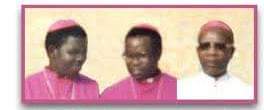05 June 1994: Kagame led Rwanda Patriotic Arms butchered : 3 bishops, priests and other people among them a toddler called Shema
THE MASSACRE AT GAKURAZO
With the advance of the forces of the RPA, the Bishops of Byumba (J. Ruzindana) and Kigali (V. Nsengiyumva*) moved to Kabgayi. It was at the end of April 1994. Bishop Thaddee welcomed them and together they examined the situation. While the RPA was more and more sure of succeeding, the Hutu militia were reacting by making a lot of people disappear. The Bishops spoke against them: “You cannot arrest without a written order and you cannot condemn without a regular process.” Words to the wind. The militia threatened them: “If you don’t accept our behaviour, we will set Kabgayi on fire.” The Bishops could have escaped by fleeing into abandon these people. Our departure would increase their fear.” On 31 May, two days before the taking of Kabgayi by the RPA, the three Bishops wrote a letter to the Holy See asking for neutrality for the town.
They decided to abandon to their refuge on the morning of the 2nd of June, when shots began to be heard in different parts of the town. The soldiers of the RPA were approaching.
Towards 11 a.m., they were so near that the bishops realized that it was impossible to flee. The doors of the bishop’s house were closed. About 3 p.m., some soldiers of the RPA succeeded in entering the bishop’s house by climbing over the wall on the side of the parish. Two priests, Fr. Muligo and Fr. Kayibanda, went to meet them. The soldiers asked for some water and told Fr. Kayibanda to accompany them into the bishop’s house, where they ordered bishops, priest, nuns and other refugees to go out.
“Who is Nsengiyumva?” asked a soldier.
Bishop Thaddee answered: We are two Nsengiyumvu here
“We are looking for Vincent.”
The archbishop raised his hand: “I am here.”
“Our commander wants to you.” They took him towards the main Kigali-Butare Road. A few minutes later the soldiers returned, took the other two bishops and the priests and made for the thicket beyond the main road. The prisoners were subjected to a first interrogation.
The day after (3.6.1994) the RPA took them to Ruhango, 20 kms away and subjected them to a lengthy interrogation. The RPA had also sent a message to the Pallottine Sisters of Ruhango asking accommodation for the Bishops for the next night. But they did not appear. They spent the night in a house beside the building of the sub-prefecture. The following day they were taken to the Josephite Brothers novitiate, at Gakurazo. The evening of 5 June, a commander said to all the prisoners in the refectory: “ Now, I have something to the Bishops and to the priest. The Sisters can go to sleep,”
In that large room the Bishops and the priests were in front of the official. Suddenly the main door was opened, and three or four soldiers aimed their guns directly at the prisoners and shot them.
A few hours later, the soldiers went to call the Sisters: You see, an undisciplined soldier has killed the Bishops. Go, please, and try to arrange things.” They said the same thing to the novices.
A terrible sight awaited the Sisters: in the refectory there was a pile of bodies and blood everywhere. They spent all the day trying to prepare the coffins, at least one for each Bishop and Bro. Jean Baptiste Nsinga, the Superior –general of the Josephites. There was some timber in the store of the novitiate. But since it was not enough for the coffins, somebody was sent to the parish to look for help. The religious who were still alive received the order to leave and go towards Busoro and Ntongwe Kinazi.
The bodies of the priest were buried in the garden beside the novitiate; those of the Bishops in the cathedral of Kabgayi. At their funeral Mgr. Venuste Linguyeneza remarked: “Nowadays in Rwanda , to do well or to do evil, seems to be the same.
NSENGIYUMVA THADDEE, BISHOP OF KABGAYI
Born in Buhambe (Bungwe parish) on March 17, 1949. Father Mathias Karagirwa; mother, Belina Kankindi Baptized on 30. 3. 1949. Primary school at Bungwe (1955-1962); minor seminary at Rwesero (1962-1969); major seminary of Nyakibanda (1969-1975). “ kind- hearted person, really good- natured calm, wise.” Priestly ordination 20.7.1975. After a period as a curate at Byumba, 1975, he, was appointed spiritual counselor and rector of Rwesero minor seminary. Studies in Rome, at the Pontifical Salesian University, where he got an M.A. in Educating Science (1.06.1982) with the dissertation Reform of the school and Development According to the programs of M.R.N.D. of Rwanda and Tanzania’s Ujamaa. Rector of the minor seminary of Rwesero, 1982.
Appointed coadjutor-Bishop of Kabgayi on 28.11. 1987. Episcopal consecration on 31. 1.1988, by Mgr. A. Perraudin, his predecessor in Kabgayi diocese. At the Ceremony were present 19 Bishops and 150 priests. A year later he succeded Mgr. Perraudin as the head of the diocese (7.10.1989).
As Chairman of the Rwanda Bishops’ Conference, he tried to get the Christian people together, particularly the young. For having organized a meeting of four days between the young of RPA and those of the government, he was strongly criticized and accused of negotiating with the enemy. He was the chairman of the Episcopal Commission for Youth and supported the project of the Youth’s National Pastoral Centre.
By the end of the 1980s he tried to discuss the national problems openly with his clergy, inviting people to reconciliation. He presided over the “Contacts Committee,” trying to put together people from different groups and trends. In the pastoral letter of 1 December 1991, he raised several questions about the credibility of the Rwandese Church in terms that no other Bishop has ever used before. “the church has become subjugated to the political power. This fact prevents some leaders to the Church from approaching the poor and announcing the Good News to them. The exceptional honors given by the establishment to the ecclesiastical authorities have transformed the Church into an ideological apparatus of the State.
When the problem concerning the schools or the Public administration arise, the leaders of the Church fear to speak out frankly and to denounce certain situations. They are afraid of offending their allies who are in power.” After having drawn up a list of the acts of violence and massacres which remained unpunished, Mgr. Thaddee continued: “The Church has never denounced openly such injustices.
She has preferred to keep silent rather than to upset the political authorities. And what about the Christians? Although aware of these facts, have they not preferred to keep silent while the flock of the Lord was decimated?”
It was he who produced the pastoral letter in February which denounced the killing of two Hutu politicians and called on president Habyarimana to move forward on the Arusha Declaration, warning that catastrophe could follow if he did not do so. In the past he had presided over the contact Committee which had achieved the Arusha Declaration. He had worked to bring about a consensus among the Churches on the need of working for reconciliation. “Bishop Thaddee wanted things to change peacefully and to find a solution for problems through negotiations.”24
Bishop Thaddee was about ton leave for the African Synod, when he listened on the radio to the news about the killing of the two Presidents and the orders not to move. The following days, he tried to invite people to be calm. But since his messages were not broadcast by the radio, he began to write letters to be at the Sunday masses.
On April 11, 1994 he wrote a letter from Gitarama, giving a short outline of the situation and invoking other nations to come and help. “The Episcopal Conference has sent a message of reconciliation through the radio on April 9, but nothing has been broadcast.’” The message had been censored. We are in favour of dialogue and reconciliation among the Rwandese must feel safe. We call people to tolerance and restraint. May the love of God overcome and may the Lord help us. All are frightened! The international community should prevent this chaos and condemn war and violence. Human rights are the same everywhere and for each person according to his socio-cultural identity. They must be respected by all. The civilization of love is still far from getting possession of our hearts.”
Since displaced people had started to arrive at Kabgayi, Bishop Thaddee organized assistance for them. Fr. Sylvertre Ndaberetse, the diocesan bursar, occupied himself with supplying food to the displaced. The small town of Kabgayi was crowded with at least 30,000 people, frightened by the militia or by the RPA.
Fr. Francois Muligo traveled often towards Burundi, to bring food donated by OPAM. Trips were always risky because of the harassments at the road-blocks. Fr. Alfred Kayibanda was assigned to the “security” committee, which had the purpose of preventing the refugees from killing each other. The refugees coming from Byumba were very angry with the RPA and the Tutsis. A plan was drawn up, in order to avoid tensions among the groups and to facilitate the flow of the refugees towards other centres. Requested for assistance, the army and the police sent a few soldiers.
The others, they explained, had had to go to the front-line. Unfortunately, the soldiers were so violent and corrupt that the Bishop protested several times. Militia went around the refugees-camps with lists of names of people to eliminate. To the protests of the Bishop, they answered: “If you don’t leave us to do our work, it means that you are an accomplice.”
Realising that the danger was more serious every day, he, brought his relatives to safety, sending them towards Gisenyi. Bishop Thaddee instigated the joint statement of the Churches on 13 May, signed by four Catholic and eight Protestant leaders, in which they condemned in vigorous terms the spreading massacres. It was all in vain. “The renegade troops who murdered him removed the one churchman who might have been most able in due course to bring the two sides together.”25 Killed at Gakurazo on 5.6.1994. The killing of Bishop Thaaddee was the result of the cynicism of some RPA leaders. (Hutu).
NSENGIYUMVA VINCENT, ARCHBISHOP OF KIGALI
Born in Remera, Rwaza parish, on August 10, 1934, of Catholic parents. Father Edouard Kimonyo; mother, Anysia Ntabwenge. Baptised on 26.8 1934 studies: philosophy at Nyakibanda, theology at the major seminary of Sion (Switzerland).
Priestly ordination on June 18, 1966 at Ruhengeri. Studies in Rome , 1966: Master in theology and Doctorate in Canon Law at the Gregoriana University . Parish priest at Ruhengeri, official of the diocesan tribunal, professor at the major seminary of Nyakibanda. He was consecrated Bishop of Nyundo on June 2, 1974. Two years later, he was appointed Archbishop of Kigali on May 3, 1976. He received the Pallium on June 20, 1976 brought by His Eminence Cardinal A. Rossi.
A warm-hearted pastor and solicitous about the welfare of his clergy, he was a devotee of the Blessed Virgin and a sincere supporter of the Kibeho apparitions. An old friend of the late President for 10 years he was the vice-chairman of the social commission of the Central Committee of MRND (Mouvement Revolutionnaire National pour le Development). To the critics who openly blamed his involvement in the political life, he used to say: “I don’t see anything wrong. I want to collaborate with a government that represents the majority.” He resigned his post in December 1985. “His departure had been openly sought by the Catholic Church and appeared to mark an official separation between the Church and the State within Rwanda.”
He was doubtful about giving up his uncritical alignment with the elite who were responsible for the impending tragedy. Nevertheless, at the Te Deum of 31 December 1993 in the cathedral, he underlined the pastoral aspect of his ministry, free from political intentions. His presence at the peace march in Kigali , the day after, and his last letters confirm some change of attitude. In his message from Kabgayi we can read
“I beg and implore each one of those who are shedding blood to stop killing. I ask the Government of Rwanda and the RPA- Inkotanyi to stop the war and the troubles that destroy our country. May the person responsible for the renewal of the hostilities recognize that it was their attack that provoked the manhunt between the Hutu and the Tutsi, between the northerners and the Southerners, among the partisans of the different political parties and led to the shedding of blood.
The F.P.R. – Inkotanyi and the Government of Rwanda will be responsible for the destruction of the country and for the blood that will flow if they do not try to stop the deadly competitions. Will they have mercy on their brother who are dying or who stay outside during the night like animals? It is not by shedding blood that Rwandan people will reach democracy. The wisdom of our ancestors says: “Two people who agree to act in concert are stronger than eight people skillful with a bow.’ So the F.P.R.- Inkotanyi and the Government of Rwanda have to negotiate without delay and decide together how to settle the transitional institutions on a broader basis. That will be the only way to restore peace.” The appeal was to the point but, unfortunately, tardy, killed atGakurazo on 5.6.1994 (Hutu).
RUZINDANA JOSEPH, BISHOP OF BYUMBA
Born in Mukingo commune, in 1943. Father, Charles Zibonukuli; mother Anastasia N. Bucyangenda. Baptized on 3.6.1943. Major seminary of Nyakibanda. “A serious seminarian with a very demonstrative character. Intelligent, exact worker, he has a strong influence on the others.” Priestly ordination on July 23, 1972. Parish-priest at Byumba, 1972. From 1973 to 1977 studies in philosophy and theology at the Human Sciences university of Strasbourg , where he received a Licentiate. Upon his return he was appointed Vicar-general and was in charge of the diocesan synod. The positive running of the synod was the result of his ability and steadfastness.
He was also visiting professor at the major seminary of Nyakibanda. From 1980 to 1981 he was director of the Propaedeutic course, at Rutongo. Consecrated Bishop of Byumba on 17 January 1982, he was president of the Episcopal Conference for two terms.
Chairman of the Episcopal Commission for the Clergy, he encouraged and animated the retreats and meeting for the priests.
The books “L’ Eglise du Rwanda, 25 ans après Vatican II and “jubilée de 754 ans de sacerdoce au Rwanda, 1917-1992,” were a result of his initiative.
A sincere man, he worked with great conviction to foster collaboration between the pastoral agents, particularly between the local ones and the expatriates. Interviewed by the magazine Mundo Negro, he had said: “Our Christian community does continuously ask its pastors to be more present in the socio-political problems and plead for the cause of the little and weak ones; to be the voice of the voiceless and a reference point for the Christian leaders.” Unfortunately his good intentions were not always understood. He was overwhelmed by the event and, his pastoral commitment in the last years did not appear so strong as in the beginning.
At the outbreak of the war in 1990, many civilians had fled the area of Byumba to escape the fighting between government forces and the RPA. On February 1993, three quarters of the population – 650,000 people – were in the camps (Nyacyonga, Rutongo, Muhura….). In an “open letter”’ the Bishop described Rwanda as a “Country going adrift” and made an ardent appeal to the politicians: “For three years a large part of the prefecture of Byumba has known physical and moral sufferings that no one of you would like to live through. The long duration of this abnormal situation will seriously damage consciences and hearts. As far as youths are concerned, it will perhaps be an irreversible process. We beg you: hurry up, please, tomorrow it will be too late!” He often visited the displaced. While the embassies encouraged their own citizens to leave, he invited the missionaries and other expatriate helpers to remain. At the end of April, he decided to move to the Bishop’s house at Kabgayi. (Hutu).
(Source: Neno Contran, MCCJ, “They Are A Target! Pauline Publications Africa New People, 1996 pp67-68, 100 “104, 104-105, 114-115
































































